Tale of a Vandal Notebook User: Going Indie, Part 3 Chronodex
There’s an update to this post here: Tale of a Vandal Notebook User: Chronodex Update (link needed)
As someone who’s worked for herself for nearly two decades now, I’m disciplined and focused. Yet I’ve been feeling in a bit of a rut. Rather than decorate said rut, I want to break through to something new. I want to identify when and where my productivity is at its best. I think I know the answer… yet also know I’ve been on autopilot lately. It’s time to shatter the “OK plateau” once again.
I’ve been experimenting with different ways to track how I spend my time. Tracking is not the same as planning time. Tracking is the “this is what really happened with time” details.
There’s been much pondering over various digital and paper planners and trackers, trying to decide the best way to capture my time spent. Then, in early November, this photo came across my twitter feed via @the_archer (thank you very much, Clem!):
What? A non-linear way to track one’s time? On paper? Of course! How wonderful!
Using a clock-like method, Patrick Ng designed his Chronodex system. Generously he provides free downloads of a yearly planner for those using a Midori Traveler’s notebook. The cost has been a prayer for his parents. Patrick’s current prayer request is for his wife who’s undergoing treatment for breast cancer.
Inspired folks have created downloads for all kinds of other notebook sizes. Check out Patrick’s site as a starting point to see what’s available.
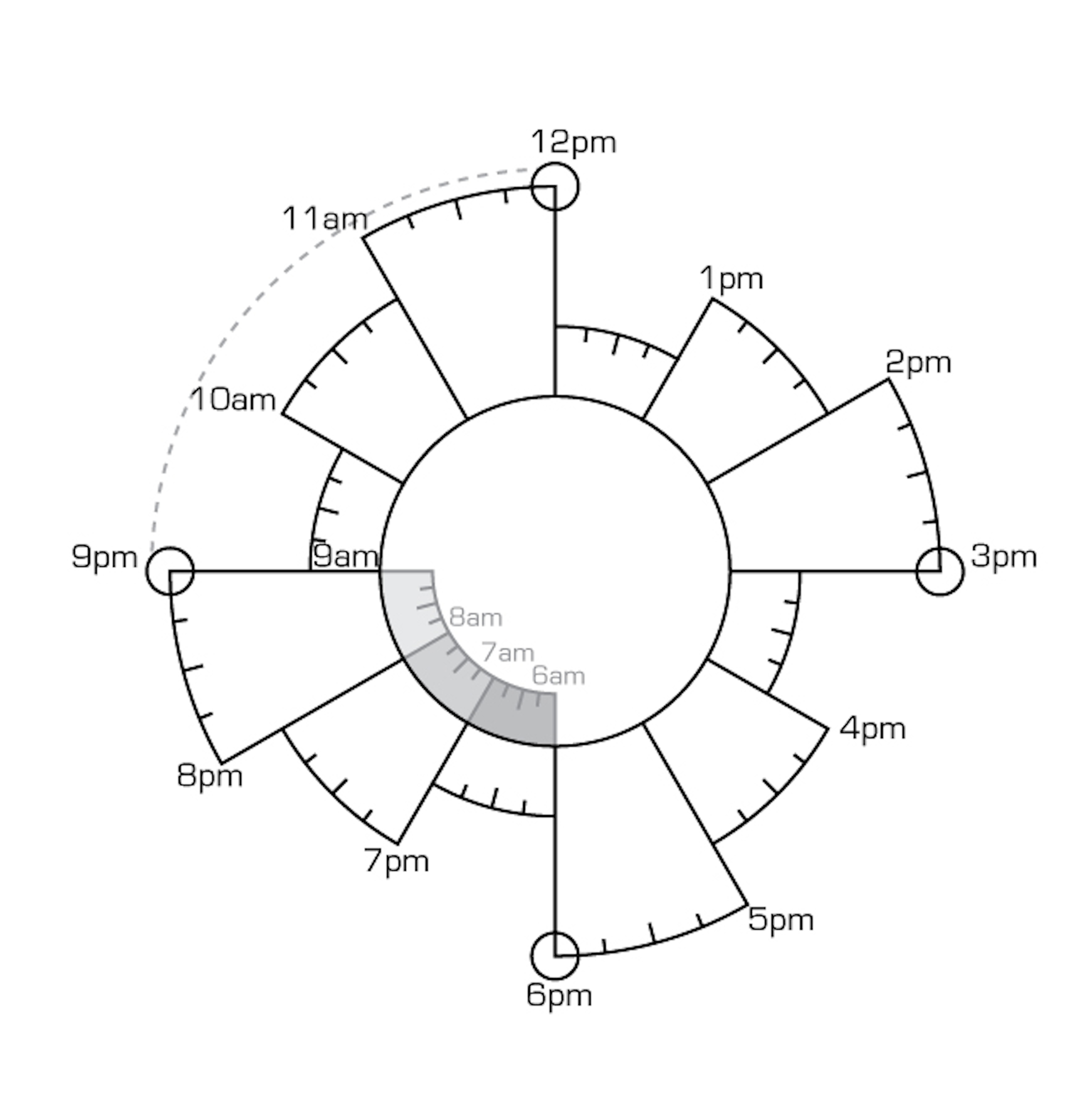 Patrick Ng’s Chronodex core. Beautiful, isn’t it?
Patrick Ng’s Chronodex core. Beautiful, isn’t it?
Essentially Chronodex is at once a day’s calendar, time planner, and recorder of your thoughts/notes. You make notations and highlight time periods on the circular image. You can highlight with colors, or any method you like. The design is meant for those who wish to work outside a traditional time planner format.
On Patrick’s blog you’ll see a lot of very colorful, artistic examples of how people use his system. About his design Patrick wrote,
Each page is like a branch of a tree, each opened page is a week, each day is like a beautiful flower grew from that page, consist of petals of your day’s time slices.—Patrick Ng, 2011 November 20
Alongside those petals, many thoughts, ideas and records may generate as you use Chronodex. For myself in practice, the Chronodex feels like a seed in that grows as I, uh, feed it during the day. Patrick refers to his “clock” as the Chronodex core. That makes much sense to me, as it reminds me of the seed or core of a piece of fruit.
As mentioned earlier, I’m not looking for a planner. I’ve got a good (yes) digital system that works. In fact I “live” by it.
There’s a place in my life for both writing on my laptop, and for my hand-written drafts. Each tool—computer and pen—toggles different parts of my creative subconscious, bringing forth different types of ideas. Having a handwritten time tracking system I suspect will uncover different information than what’s already being captured in my digital planner.
My experiment with Chronodex is to use it to record my day, almost like a diary of sorts. I’m looking for patterns time spent to see where there’s stagnation, and where there’s some surprises. Last December committing myself to using Chronodex for the month, my experiment began.
For now I can really only report my blips, false starts, and reboots using Chronodex. I haven’t been using it very long at all, and can’t yet provide a good assessment of it. An assessment of my use, that is. Here at the end of December there remains a feeling within me there is something more in Chronodex to learn from. My experiment will continue through the end of February so that new learnings have a chance to identify themselves.
Because my time record is not meant to be a planner, I’m not using Patrick’s planner template; only his Chronodex core image. Using a core without a pre-printed date allows me to hand write the day’s date in the center circle.
Early on, I got confused a lot by how the early morning hours were laid out on the core, and kept filling my morning hours into what were meant to be evening hours. My day starts early, and the morning is my busiest part of my work day. Or so I believe.
A very slight adjustment was helpful: I moved my evening hours into where Patrick had placed the very early morning hours. Sometimes it’s the little things that keep you going.
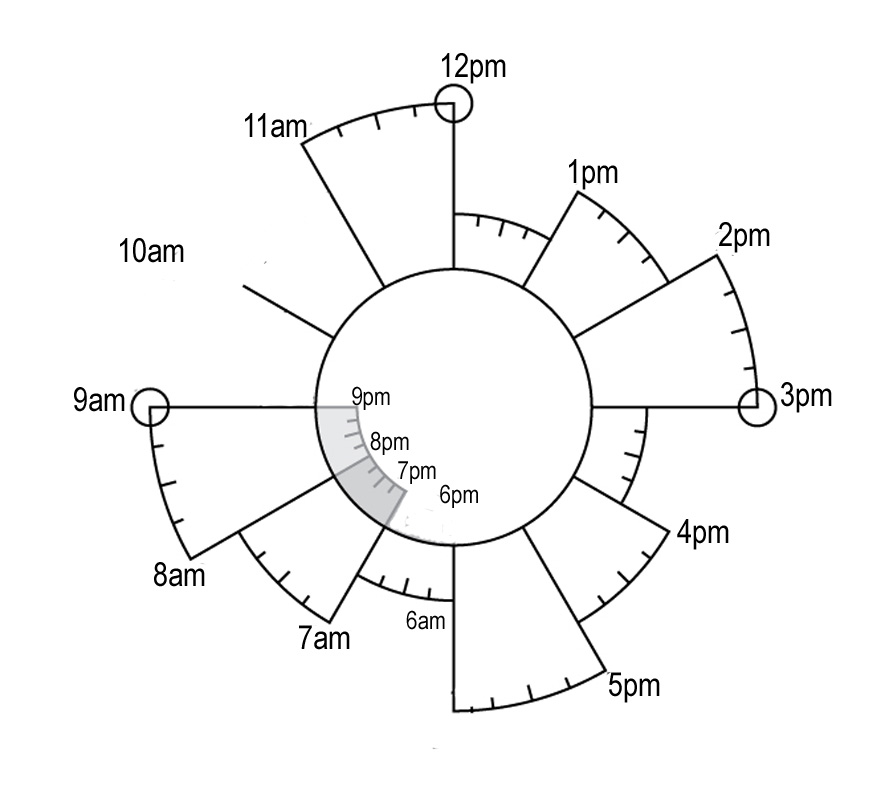
As I reflected on my use of the Chronodex core, I felt wasn’t “getting” the full benefit of Patrick’s design. And so I transformed the core into something that felt more comfortable and more like a 24-hour clock. Then I abandoned that modification, and went back to Patrick’s original Chronodex core because it looks so elegant and freeing. Yet, I ended up abandoning it once again. Perhaps I can’t work outside the box? *sigh*
Here’s my current transformation of Chronodex with humble apologies to Patrick and his elegant work:
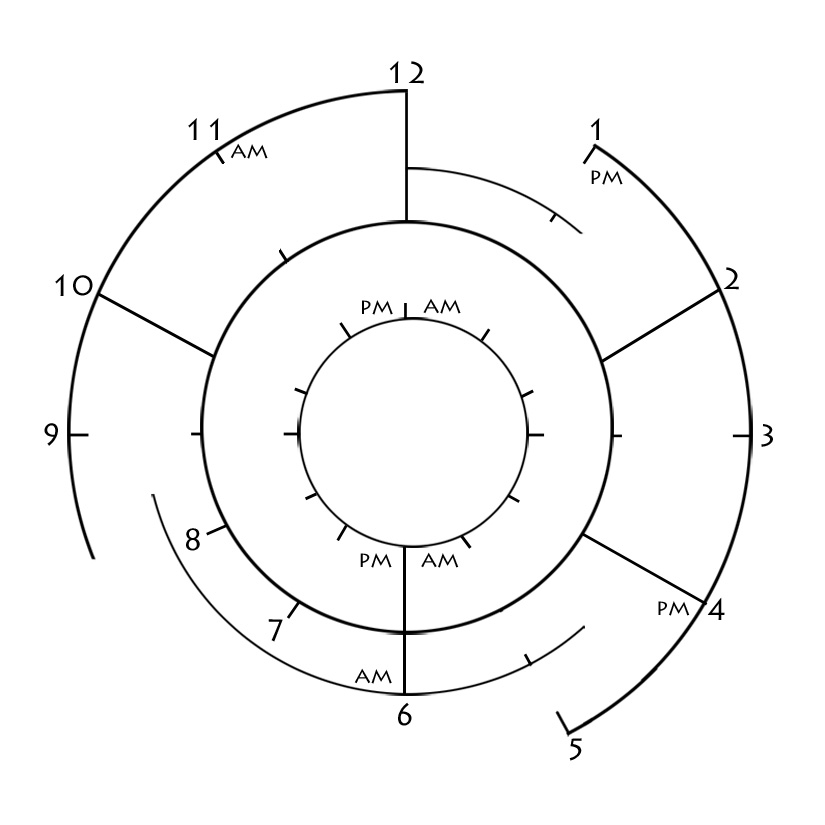 The core as I’m using it as of this post. Need to do a better job next time at measuring the time marks, ay? Not perfect, but it’s working. You are free to use it. (No! Why would you?) If I fix it, I’ll update the above graphic. Why don’t you use Patrick’s instead? Whatever you do, please send out your prayers as Patrick has requested.
The core as I’m using it as of this post. Need to do a better job next time at measuring the time marks, ay? Not perfect, but it’s working. You are free to use it. (No! Why would you?) If I fix it, I’ll update the above graphic. Why don’t you use Patrick’s instead? Whatever you do, please send out your prayers as Patrick has requested.
Time Tracking Notebook
My time tracking notebook involves an inexpensive, refillable notebook cover. (Frankly I can’t recommend it, as the cover felt made without a lot of care.) My, uh, starving artist’s notebook uses large rubber bands to hold a 3 x 5 notebook inside the cover.
For paper, wanting something thinner than my normal HP 32# paper, I decided to use 20# Staples sugarcane copy paper. The paper is 95% sugarcane bagasse. The paper is fountain pen friendly, inexpensive, and doesn’t contain much tree paper. To the touch, the paper feels very much like ordinary copy paper made from trees. The paper is white. Not bright white. More gray “bleh” white. I’ve had no ink bleeding through to the back of the paper using even a broad Japanese nib or with wet, fine European nibs. YMMV, of course. (I thank members at FPGeeks for talking up the Staples copy paper. That thread lead me to it.)
My cost was $20 complete for the notebook (one-time cost), and less than $.08 for a month’s worth of printed pages. Pretty happy with that consumable cost!
My notebook is small enough that I can carry it in my back jeans pocket. It’s always with me. That’s essential.
For the pages: Four images are printed per 8.5” x 11” page, on both sides of the paper. One 8.5” x 11” page provides 8 days worth of pages. The copy paper is cut down to 7” x 11”, and then once more to 3.5” x 5.5”.
The paper is folded using a bone folder, and slipped into the notebook cover. Originally I was going to stitch the month’s pages together. The bands used with the cover hold the paper quite tightly in place. Stitching pages to keep them together was unnecessary.

Fresh notebook pages. As you can see, only the image is printed. No extraneous “to-do” or whatnot items here! The day’s date is hand written in the center circle.
Stitching the pages may be a good idea if these pages are kept as any kind of archive. I’m undecided. I’m not as invested in paper keeping as a lot of my friends are, tending to scan papers into Evernote for permanent record-keeping. More to be revealed as I write along and experiment, ay?
I don’t use pre-printed dates in order to give myself permission to not record anything on any given day. Mostly I’m tracking planned writing days. Remember, this is an experiment, not a journal or absolute record of my life. No doubt about it: the tracking process will evolve as I play with it.
What I like about Chronodex: the visual check on how my time was spent. As I move between tasks, projects, appointments, and, uh, nothing-ness, I scribble a little something on the core or elsewhere on the page. I record the day’s word count, and any notes I was moved to make. I also use a personal emoticon reflecting the day’s overall feeling. The page can be scribbled over in my usual free-form mess, and I don’t feel hemmed in by a lot of pre-printed stuff never used.
The Chronodex has given me a reason to use some radically different colors beyond my daily blue (Pilot Blue-Black). Who knew? Story writing time might be captured using Sailor Sei-Boku or Ultra Marine, and non-writing time might be either Sailor Apricot, Epinard or Pilot Blue. Well… I’ve not been consistent yet.
Different colors, obviously, can be visual cues of the day’s outcome. I’m still figuring out how color will work best for me. Some folks color code their time. Some folks are monochrome about their entries. Not sure yet what will work best for moi.
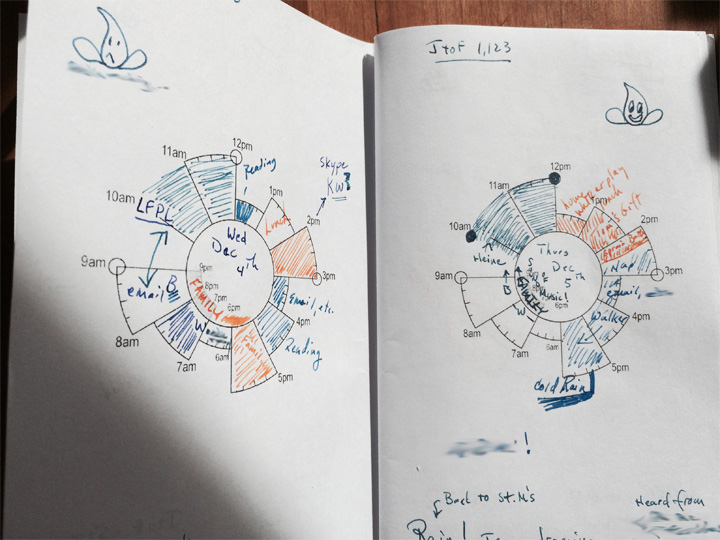
Some early pages… finding my way.
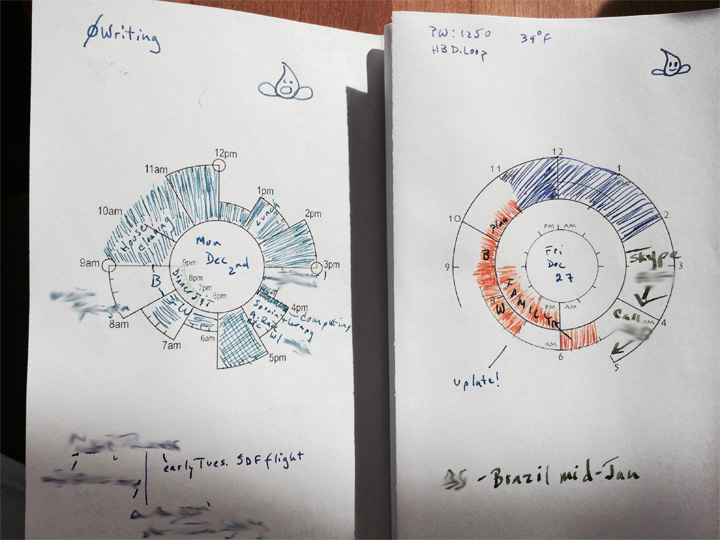
Left: an early tracking page. Right: current style tracking page. Still figuring out how I want to use color to emphasize various times during the day.
And what about fountain pens? The pen usually clipped to my notebook is a Platinum Kanazawa-Haku inked with Sailor Sei-Boku.

The pen’s thin enough to keep the notebook pocket friendly. My Pilot MYU701, always inked with Pilot Blue, is also a constant at the ready. The Levenger True Writer has also been enlisted. It’s inked with Sailor Yellow-Orange ink.

Levenger True Writer helps the cause. You can see I’m still working out how I want to capture time segments. The lined dark lines represent writing or editing time. The yellow/orange color personal and family time.
As my experiment ambles along towards the end of February, we’ll see if the core gets tweaked again or even abandoned. Perhaps I’ll even return to Patrick’s original design. Patrick has blogged that he will give Chronodex tips during 2014. I look forward to them.
Please visit Patrick Ng’s Scription blog. You’ll find 2014 Chronodex planner pages waiting for you there:
2014 Chronodex Planner by Patrick Ng
You’ll also find other folks contributions and download links via Patrick’s Facebook Chronodex page (please reserve your anti-Facebook rants for elsewhere, ay?) Patrick announced his determination to release a Chronodex stamp in 2014, and you will find updates about that project on the Facebook page.
Thank you, Patrick! While I’m late to discover your work, I’m very inspired by it in my small way.
It is cruel to waste someone’s time, and in that vein I’m grateful to those of you who read my lengthy posts. I hope you find them worthy of your time.
Wishing everyone adventurous times in the days ahead—plot them well!
Note: There are 8 exclamation points in this post. I meant every one of ‘em.
Related Indie Notebook Posts (links not up yet)
- Tale of a Vandal Notebook User: Going Indie, Part 1
- Tale of a Vandal Notebook User: Going Indie, Part 2